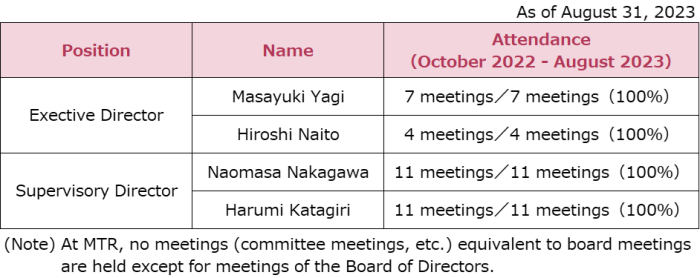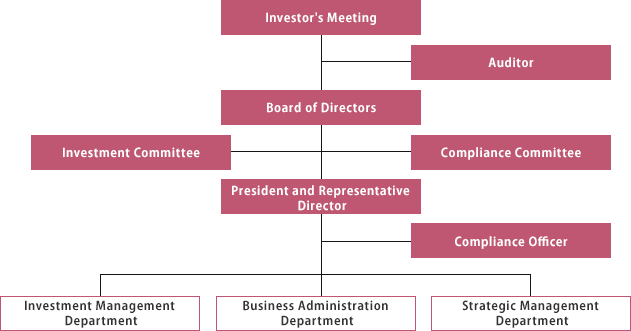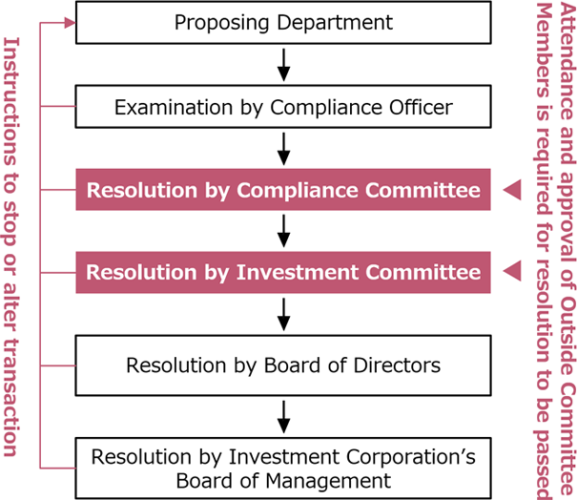Governance Initiatives
- Policies and
Management Structure - Climate Change
Initiatives - Environmental
Initiatives - Social
Initiatives - Governance
Initiatives - External assessment
- Sustainability Report
(Issued July 2023)
MTAM aims to help improve tenant , hotel operator and hotel user satisfaction and contribute to the sustainable development of local communities by building good relationships with external stakeholders related to the real estate MTR holds and cooperating and collaborating with them in accordance with the “collaborating with external stakeholders” strand of its sustainability policy.
Corporate Governance
The organization of MTR consists of the Shareholders' Meeting comprised of unitholders, one Executive Director, two Supervisory Directors, the Board of Management comprised of the Executive Director and the Supervisory Directors, and the Accounting Auditor.
Details of Organization
(a)General Meeting of Unitholders
Certain matters concerning MTR as set forth in the Act on Investment Trusts and Investment Corporations (“AITIC”) or the Articles of Incorporation are decided by a resolution of the Shareholders' Meeting , which shall be composed of unitholders. Unless otherwise stipulated in laws or the Articles of Incorporation, a resolution at the General Meeting of Unitholders will be made by the majority of the voting rights of the unitholders present. However, certain important matters, including amendments to the Articles of Incorporation, require a resolution made by two-thirds or more of voting rights of unitholders present, provided that unitholders holding investment units equivalent to majority of total investment units issued are present (special resolution).
With regard to all investment units issued, each unitholder holds voting rights at a ratio of one voting right for each investment unit held by the unitholder.
(b)Executive Director, Supervisory Directors and Board of Management
The Executive Director executes the business of MTR and also has the authority to take any judicial or extra-judicial acts related to the business of MTR on behalf of MTR. A Supervisory Director has the authority to supervise the conduct of business by the Executive Director. The Board of Management is composed of the Executive Director and Supervisory Directors and has the authority to approve the execution of specific responsibilities as well as the authority set forth in the AITIC and the Articles of Incorporation and the authority to supervise the execution of duties by the Executive Director.
The appointment and dismissal of Executive Directors and Supervisory Directors will be made by resolution of a General Meeting of Unitholders in accordance with the provisions of the Act on Investment Trusts and Investment Corporations and the Articles of Incorporation.
(Status of Investment Corporation's Board of Management meetings)

(c)Accounting Auditor
MTR has elected Ernst & Young ShinNihon LLC as the Accounting Auditor. The Accounting Auditor will audit MTR's financial statements and other relevant material, report to Supervisory Directors in the event of detection of a fraudulent act or material fact violating any law or the Articles of Incorporation concerning execution of duties of the Executive Director and perform other duties stipulated in laws.
Organization of MTR

Status of Directors
The status of the Executive Director and Supervisory Directors is as shown below.
Criteria that apply to the payment of remuneration to Executive Directors and Supervisory Directors are specified in MTR's Articles of Incorporation decided pursuant to a resolution of Investors' Meeting.
(Executive Director) An amount determined at a meeting of the Board of Directors with a maximum of 800,000 yen per month.
(Supervisory Director) An amount determined at a meeting of the Board of Directors with a maximum of 500,000 yen per month.


Directors' Investment Unit Holding Policy
From the viewpoint of preventing insider trading, the "Corporate Relationship Information Management Regulations" at MTR stipulate that directors of MTR must not buy or sell MTR’s investment units, and none of the executive directors or supervisory directors hold MTR’s investment units.
Status of Accounting Auditor
The status of the Accounting Auditor is as shown below.

Status of Unitholders
MTR's principal unitholders (the top ten entities with the highest holding ratios) as of the end of February 2023 are as shown below.
MTAM's Organizational Structure
MTR entrusts asset management to MTAM. MTAM's organizational structure is as shown below.

Compliance Structure
Basic Compliance Policy and Structure
MTAM has set compliance with laws, regulations and other rules as one of its management priorities and MTAM's management is actively working to develop and strengthen the compliance structure and internal control structure. To establish an appropriate operational structure, MTAM has appointed a compliance officer as the person responsible for compliance-related matters at MTAM to ensure that internal checks and balances on other departments function effectively.
Furthermore, through the establishment and operation of the Compliance Committee, MTAM has established a multi-tiered structure for ensuring MTR's compliance with laws, regulations and other rules.
(a)Board of Directors
The Board of Directors seeks to ensure compliance as the organization with ultimate responsibility for the execution of business and, besides receiving reports on matters approved by the Compliance Committee, also makes resolutions on important compliance-related matters at MTAM, including formulation and amendment of the basic policy on compliance and compliance program, formulation of the risk management plan and internal audit plan, as well as appointment and dismissal of Compliance Committee members and the Compliance Officer.
(b)Compliance Committee
The Compliance Committee consists of the President and Representative Director, directors (including non-executive directors), the Compliance Officer, and one or more persons qualified as lawyers or certified public accountants or persons who are otherwise deemed to be familiar with compliance (limited to those who have no relations in the asset management company, or the matters handled by the asset management company). The Compliance Committee is chaired by the Compliance Officer.
The Compliance Committee is responsible for execution of the duties set forth in the Compliance Committee Rules in cooperation with the Board of Directors and Compliance Officer.
(c)Compliance Officer
As the person responsible for compliance at MTAM, the Compliance Officer works to establish an internal compliance structure and to raise awareness of norms for compliance with laws, regulations and other rules within the company. The Compliance Officer, therefore, constantly monitors whether MTAM executes asset management business in accordance with laws, regulations and other rules, and also monitors and supervises the status of compliance in the exécution of day-to-day operations.
In light of the importance of the Compliance Officer's responsibilities, MTAM elects as Compliance Officer an individual who is sufficiently capable of examining and supervising business execution to achieve compliance with laws, regulations and norms.
MTAM has put in place a structure such that any act pertaining to MTAM's business operations that violates or is likely to violate laws and regulations discovered by any officer or employee is reported immediately to the Compliance Officer.
Appropriate Management of Conflicts of Interest
To prevent MTAM from engaging in transactions with related parties sharing certain interests with MTAM which may be harmful to the interests of MTR, MTAM has identified types of related party transactions and set forth related party transactions standards and comprehensively judges whether to conduct a transaction through deliberation by more than one body. MTAM elects outside specialists as committee members to both the Compliance Committee and the Investment Committees that hold such deliberations.
If the acquisition of an asset or other transaction by an investment corporation which entrusts its asset management to MTAM constitutes a related party transaction, the approval of the outside committee members of the Compliance Committee and Investment Committees are required. Details of this decision-making process are as shown below.

Exclusion of Antisocial Forces
MTAM has formulated the Basic Policy to Prevent Damages Caused by Antisocial Forces in order to exclude antisocial forces and groups that threaten public order or stability and obstruct the economic activity of companies and individuals.
The Policy sets out that the organization as a whole will deal with unjust demands by antisocial forces, that MTAM will establish close and cooperative relationships with external specialist organizations such as the competent police, the National Center for Removal of Criminal Organizations, and legal practitioners, that it have no relations with antisocial forces including business relations, and that it will refuse any unjust demands by antisocial forces.
Prohibition of Insider Trading
MTR and MTAM established respectively its Corporate Information Management Rules to prohibit MTR's officers and MTAM's all its officers and employees (including temporary employees, contract employees, and employees on loan or dispatched from other companies and officers) from engaging in transactions such as trading securities including MTR's investment units, based on corporate information or other special information that they have obtained in the course of operations by taking advantage of their titles and positions.
Relations with politicians and governments
MTAM’s Basic Policy on Compliance stipulates that it shall maintain transparent and sound relations with politicians and governments.
It has never made any political donations in the past.
Prevention of Bribery and Corruption
MTAM has the Rules of Employment and the Basic Policy on Compliance in place to ensure that all managers and employees do not engage in any type of fraud or corruption, including the offering or accepting of gifts, entertainment and/or other benefits beyond socially accepted limits, money laundering, acts of bribery including the offering of economic benefits to public officers and acts of pursuing their own interest by taking advantage of their positions, with strict disciplinary action applying for any violation of such rules.
With respect to acts of fraud and corruption, there has been no material violation or any record of paying penalties, surcharges or settlement money to date.
No employee has been subject to reprimand or dismissal due to acts in relation to bribery or corruption.
In addition, we are fully committed to ensuring that all managers and staff members thoroughly understand the content of the Rules of Employment and the Basic Policy on Compliance. Measures for the prevention of acts of fraud and corruption are properly integrated into the company-wide risk management program and management.
Please see the following regarding outline of the company-wide risk management program.
Establishment of Whistleblowing System
MTAM has a whistleblowing system in place for all its officers and employees (including temporary employees, contract employees, and employees on loan or dispatched from other companies, employees not running in a year from whistleblowing and officers).
This system is used for whistleblowing to report acts involving organizational or individual violations of laws and regulations, including any type of fraud or corruption such as the offering or accepting of gifts, entertainment and/or other benefits beyond socially accepted limits, money laundering, acts of bribery including the offering of economic benefits to public officers and acts of pursuing personal interest by taking advantage of one's position.
A whistleblower can make a report anonymously. In addition, in accordance with the Whistleblower Protection Act, it is prohibited to carry out dismissal, disciplinary measures, retaliation or any other treatment that is disadvantageous to a whistleblower on account of such whistleblowing.
Provision of Regular Compliance Training
MTAM provides all its officers and employees (including temporary employees, contract employees, and employees on loan or dispatched from other companies and officers) with training mainly aimed at raising compliance awareness on a regular basis.
Conduct of Audits of All Business
The Compliance Officer of the Asset Management Company is in charge of internal audits and, in principle, conducts regular internal audits of all operations of all departments (investment management structure, financial management structure, legal compliance structure, compliance with ethical standards, anti-corruption, etc.) at least once every six months. In addition, the Compliance Officer may conduct extra audits at his/her discretion and may conduct special audits at a determination of the President and Representative Director or an Internal Audit Manager.
Risk Management
Basic Risk Management Policy and Structure
With risk management positioned as one of its management policies, MTAM is facilitating risk management according to the Risk Management Regulation set forth for ensuring the continuity and stable growth of businesses and soundness of management.
The Asset Management Company has also established the following risk management system.
(a)Board of Directors
The Board of Directors makes decisions on the formulation and revision of plans for risk management (Risk Management Plan) and receives regular reports from the Compliance Officer on the progress of the plan.
(b)Compliance Officer
The Compliance Officer, as the Chief Risk Management Officer, establishes and maintains the risk management framework of the Asset Management Company and controls operations related to risk management.
(c)General Managers
The general managers as risk management managers establish and maintain a risk management framework under their jurisdiction, and control and execute operations related to risk management under their jurisdiction.
Risk Management Process
In accordance with the "Risk Management Regulations," the Asset Management Company practices company-wide risk management by conducting risk assessments and formulating a "Risk Management Plan" every fiscal year, as well as by regular checking on the progress of the plan. The risk management process is as follows:
① Identify risk items in each department by risk category.
② Assessment of "frequency of occurrence (possibility of occurrence)" and "scale of damage (impact)" of each risk.
③ Based on the results of the above assessment, determine which risk items could be material risk items.
④ Set management targets and formulate response measures for each determined material risk item.
⑤ Assessment of the implementation status of response measures, and report on the results of the assessment and corrective/improvement matters based on the assessment.
Education and training
Chief Risk Management Officer or risk management officers provide all managers and staff members with education and training to make sure that they understand and recognize risk management and the importance thereof.
Information Security
MTAM enacted the Information Management Rules with the aim of properly utilizing company information and preventing information incidents including unauthorized access and the loss or leak of company information.
The rules aim to ensure information management by providing for training and audits on the management of confidential information, restriction of unauthorized access, prevention of information leaks, maintenance of information systems and information system.
Same Boat Investment by Sponsor Group
MTR aims to improve unitholder value by aligning sponsor interests with those of unitholders.

Customer-oriented Business Conduct
MTAM adopted the Principles for Customer-Oriented Business Conduct announced by the Financial Services Agency on March 30, 2017 and set forth a Policy on Customer-Oriented Business Conduct as set out below.
